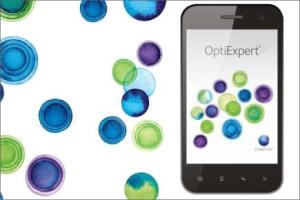by Dr. Jennifer Stewart

One of the biggest tools for success for streamlining my contact lens examinations is utilizing OptiExpert in the exam room, especially with multifocal and toric patients[1],[2]. One of the biggest hesitations I hear from colleagues in utilizing lenses such as multifocals is the increased chair time, extra patient visits, and decreased success. By using OptiExpert for my initial lens selection, I have increased my rate of success in these lenses,[3] shortened my exam time, and significantly decreased how many contact lens follow-ups are needed2.
OptiExpert is a contact lens calculator that is available for smartphone, tablet and computer use. It can be found on the App Store, Google Play or on the web. It features a sphere, toric, multifocal, and toric multifocal calculator that will save time by recommending CooperVision contact lenses based on an entered spectacle prescription.2 There are also oxygen profiles available to aid eye care professionals (ECPs) in demonstrating the oxygen transmissibility provided by a silicone hydrogel contact lens in comparison to lenses from other manufacturers.
How do I utilize OptiExpert to increase efficiency, patient satisfaction and revenue?
OptiExpert in the exam room
Our office uses scribes, who function as super techs. These team members pretest patients, gather ocular and medical history, perform entrance testing and stay in the exam room to enter all the findings into our EHR using tablets. We have OptiExpert installed on all of our tablets, and every scribe is well versed in how to enter in prescriptions and what information is available. During an exam, the scribes are listening to my conversations with my patients and know my “script” when talking about certain lenses, such as multifocal and toric lenses. They will automatically open OptiExpert and enter the patient’s spectacle prescription, as well as eye dominance for multifocal lenses. They will have the screen open showing all CooperVision lenses available for that patient, and usually know my choice based on my typically prescribing habits. While I am doing the slit lamp portion of the exam, my scribe exits the room and finds the diagnostic lenses for that patient. By the time I am done with the ocular health portion of my exam, the contacts are ready and waiting for the patient. We have streamlined this process to take no additional time, and the patient doesn’t even see the scribe leave the room- it’s our bit of magic! The patient will then insert the lenses and leave with them. Our office follows up by phone in 3-5 days to check on the patient and orders the annual supply if the patient is ready.
But What If a Change Is Needed?
I like to set my team up for success, and have any changes in contact lens prescriptions be as efficient as possible. Based on the patient’s feedback in the chair, I’ll often enter “next steps” in my EHR, in case I am out of the office when the patient is reached for a follow up phone call. Instead of my contact lens technician waiting on me, they can easily set aside the next set of diagnostic lenses for the patients for on their needs (sharper distance vision, sharper reading vision) based on my planned changes. This allows for seamless communication and care for a patient, whether I’m in the office or not.
Is There A Lens For Me?
I love when patients who have previously struggled to find a lens for their prescription comes to my office- I know there is likely a CooperVision product available to suit their needs. I always tell patients- if it is out there, I will find it! While I pride myself on having a great memory for patient’s names and faces, I can’t seem to remember the parameters available for all CooperVision lenses (there are a lot!) I often go back to my office at lunch or the end of the day and use OptiExpert myself to order lenses for more complex patients whose lenses are not quite “off the rack”. I let patients know that I myself am going to find the right lens for their needs, and they seem to appreciate the customized approach. I also like knowing I can use OptiExpert from home. I am not in the office every day seeing patients, so my staff know I can help with lens selection even from home.
I’m Fine With What I Have
I love talking to my patients about eye health, especially when it comes to oxygen and contact lenses. For many, understanding the relationship of oxygen transmissibility and corneal health is very abstract and hard to understand. The oxygen profiles in OptiExpert can show a patient the difference between their current lens and a new lens, as it pertains to their cornea. Patients don’t have to be scientists to see the difference and understand how new materials can benefit their eye health long term. Patients can see where their current lens lands on the Dk/t spectrum in regard to the minimum recommended central oxygen transmissibility to avoid corneal swelling. These are such important talking points when a patient is wearing a lens that falls below this requirement. This can also be significant in increasing practice revenue by making changes to more profitable lenses in the office.
But…I Don’t Have Time!
None of us want to add to the list of things we need to do in the exam room- but using OptiExpert has only streamlined my approach. I’ve always been one to use contact lens fitting guides (no need to reinvent the wheel) so for me, having a high-tech option that replaces a paper copy of a fitting guide saves me time. I find that patients love that the lenses magically are waiting for them, and my scribes have become experts at “reading my mind” when multiple lenses are options. OptiExpert is such a value add to a busy practice, and also lessens my chair time2 and how many follow up appointments are needed. I find it very rare that a third set of diagnostic lenses are needed- most of my finalized prescriptions come from the first or second set a patient uses.3
In a time when we are trying to maximize every patient encounter and become as efficient and effective as possible in the exam room, a tool such as OptiExpert is an essential part of my exam room tools.
[1] CVI data on file 2019. Retrospective analysis; N=55 subjects (110 eyes); DV Rx +1.25D to -3.25D, add powers +1.25 to +2.50DS.
[2] Luensmann D et al. Toric lens fitting success supported by an online fitting App. Poster to be presented at NCC/BCLA 2020.
[3] Woods J et al. Validation of a multifocal contact lens online fitting app. BCLA poster presentation 2019. Retrospective analysis refraction data with OptiExpert® (n=96 eyes) with Rx range +5.00 to -6.00DS, ≤ -1.00DC; ADDs +1.50 to +2.50D.








